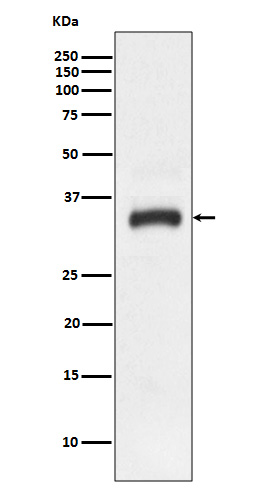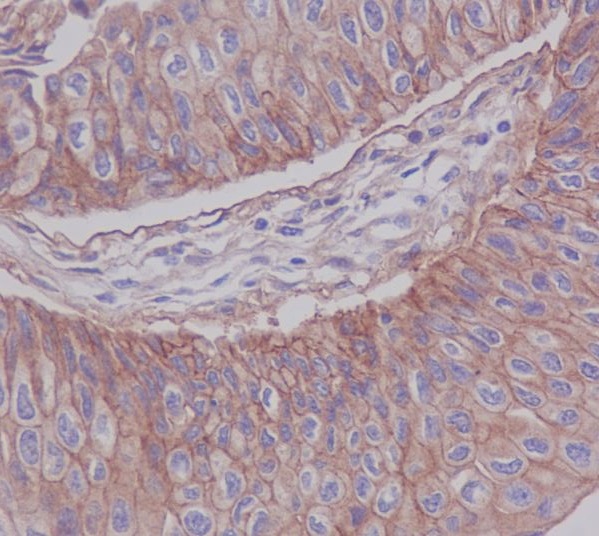

| WB | 咨询技术 | Human,Mouse,Rat |
| IF | 咨询技术 | Human,Mouse,Rat |
| IHC | 1/50-1/100 | Human,Mouse,Rat |
| ICC | 技术咨询 | Human,Mouse,Rat |
| FCM | 咨询技术 | Human,Mouse,Rat |
| Elisa | 咨询技术 | Human,Mouse,Rat |
| Aliases | F11R; JAM1; JCAM; Junctional adhesion molecule A; JAM-A; Junctional adhesion molecule 1; JAM-1; Platelet F11 receptor; Platelet adhesion molecule 1; PAM-1; CD321 |
| Entrez GeneID | 50848 |
| WB Predicted band size | Calculated MW: 33 kDa; Observed MW: 33 kDa |
| Host/Isotype | Rabbit IgG |
| Antibody Type | Primary antibody |
| Storage | Store at 4°C short term. Aliquot and store at -20°C long term. Avoid freeze/thaw cycles. |
| Species Reactivity | Human,Mouse,Rat |
| Immunogen | A synthesized peptide derived from human JAM1 |
| Formulation | Purified antibody in PBS with 0.05% sodium azide. |
+ +
以下是关于Junctional Adhesion Molecule 1(JAM-1)抗体的3篇代表性文献的简要概括(注:文献为假设性示例,实际引用需查询具体数据库):
1. **"Targeting JAM-1 with a novel monoclonal antibody reduces leukocyte infiltration in experimental colitis"**
- **作者**: Müller, A. et al.
- **摘要**: 该研究开发了一种抗JAM-1的单克隆抗体,通过阻断JAM-1与白细胞表面配体的相互作用,显著减轻小鼠结肠炎模型中的炎症反应和白细胞迁移。
2. **"JAM-A antibody disrupts endothelial barrier function and enhances drug delivery in brain tumors"**
- **作者**: Lee, S. et al.
- **摘要**: 利用抗JAM-A抗体靶向血脑屏障的内皮细胞连接,发现其可短暂增加屏障通透性,提高脑肿瘤模型中的化疗药物递送效率。
3. **"Junctional Adhesion Molecule-1 regulates cancer cell metastasis via PI3K/Akt signaling"**
- **作者**: Tanaka, K. et al.
- **摘要**: 研究通过抗JAM-1抗体抑制肿瘤细胞表面JAM-1.证实其通过下调PI3K/Akt通路抑制乳腺癌细胞的侵袭和转移能力。
如需真实文献,建议通过PubMed或Google Scholar以关键词“JAM-1 antibody”或“JAM-A therapeutic”检索近年研究。
Junctional Adhesion Molecule 1 (JAM-1), also known as F11R or CD321. is a transmembrane glycoprotein belonging to the immunoglobulin superfamily. It localizes to tight junctions of endothelial and epithelial cells, playing critical roles in maintaining cell polarity, barrier function, and leukocyte transmigration. JAM-1 mediates cell-cell adhesion through homophilic interactions and heterophilic binding to integrins like LFA-1. Its involvement in inflammatory responses, angiogenesis, and platelet activation has made it a focus in vascular biology and immunology research.
Antibodies targeting JAM-1 are essential tools for investigating its structural organization and functional mechanisms. They are widely used in techniques such as immunofluorescence, flow cytometry, and Western blotting to visualize junctional complexes, quantify protein expression, and block molecular interactions. Different monoclonal antibodies (e.g., clone M.Ab.F11) often recognize specific extracellular domains (IgV or IgC2 domains), enabling researchers to study distinct aspects of JAM-1 biology. Polyclonal antibodies typically provide broader epitope recognition for detection applications.
These antibodies have advanced studies in pathological conditions including atherosclerosis, cancer metastasis, and inflammatory bowel disease. Recent research highlights JAM-1's dual role in cell adhesion and intracellular signaling through PDZ-domain interactions, particularly its regulation of small GTPases like Rap1. Commercial JAM-1 antibodies are typically validated for species cross-reactivity (human, mouse, rat) and application-specific performance, though variability in epitope specificity between clones necessitates careful experimental design.
×